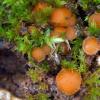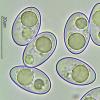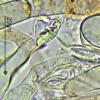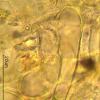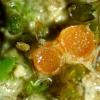
15-12-2025 07:09
 Danny Newman
Danny Newman
indet. Rutstroemiaceae sp. on unk. fallen leavesMc

15-12-2025 21:11
 Hardware Tony
Hardware Tony
Small clavate hairs, negative croziers and IKI bb

15-12-2025 15:54
 Johan Boonefaes
Johan Boonefaes
Unknown anamorph found on the ground in coastal sa

15-12-2025 15:48
 Danny Newman
Danny Newman
Melanospora cf. lagenaria on old, rotting, fallen

15-12-2025 07:05
 Danny Newman
Danny Newman
Pseudosclerococcum golindoi (det: Zotto)near Cosb

15-12-2025 11:49
 Danny Newman
Danny Newman
ITS sequences from the following two collections B

15-12-2025 12:34
 Danny Newman
Danny Newman
indet. Rhytismataceae on oak leafnear Purchase Roa

09-12-2025 12:06
 Andgelo Mombert
Andgelo Mombert
Bonjour,Je recherche l'article concernant Hypobryo

Hola a todos.
Subo fotos de una Octospora encontrada ayer, entre musgos, en una finca de cultivo de olivos.
Miden hasta 3 mm de diámetro.
Esporas de 17,5-22 x 11,5-13,5 micras.
¿Qué os parece?
Gracias por su ayuda.
Rubén
no es O. grimmiae y no es Grimmia pulvinata.
Puede ser O. gyalectoides pero no soy seguro, tu otra Octospora es O. gemmicola.
Saludos,
Marcel
in my opinion, you found Octospora gyalectoides (=crosslandii). The spores are typical for that species. The apothecia margin is variable in O. gyalectoides and Benkert (2007) pointed out, that O. gyalectoides probably represents a complex of several species without sufficient morphological differentiation for recognition.
Your arrows show a Pottia, but Didymodon and Pseudocrossidium are also present on your photo. However Pottia is the most common host for O. gyalectoides.
with best wishes
Jan

Muchas gracias por su ayuda, Marcel y Jan.
Un saludo
Rubén
